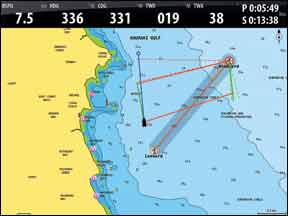The cheapest wind indicators are bestowed at birth: your nose, the back of your neck, and your fingers. Forget digital precision; these wind indicators are dialed in. They even sense changes in temperature that, in squally weather, can signal a sudden backing wind. Even the most sophisticated wind sensors can’t compete with a direct skin-to-brain link.

The next step up from our dermal cells is a bit of yarn in the shrouds-super light Angora wool, if youre a stickler. Here, the eyes intervene in the process, so the brain must do a bit more exercise. Well call this soft technology.
The next level of sophistication-tell-tales on the sails-are great for racers … or novice cruisers who still naively steer for windward destinations. On the mainsail, there should be a tell-tale on the leach for every row of battens, or at one-quarter, one-half, and three-quarters of the way up the leach. The spacing on the jib is the same, although some sailors attach as many as six per side-red yarn or nylon on the port side, green on the starboard. Be sure to stagger the jib tell tales about six inches apart on either side of the luff, so you don’t need to distinguish the color to detect which yarn is lifting. A simple windex at the top of the mast to check relative wind angle is the final step before entering the world of wind-detecting extravagance.
While exploring the Miami Boat Show this winter, we found a range of new devices that sense the wind, and some convert it into data or imagery we can use. Heres the rundown from the most to least sophisticated:
B&G Sailsteer
We first played with an early version of what is now called Sailsteer in 2012, and B&G has continued to refine this product, which is tuned into the needs of the cruising or racing sailor. The Sailsteer software helps take much of the guesswork out of when to tack to take the best advantage of wind and tidal currents. The software carries out what B&G calls SailTime calculations. Wind input provides a birds eye view of laylines and tacking angle, and calculates ETA on the fly.

Although weve only been able to demo this product briefly, our initial experience has been positive. The software is compatible with B&Gs new Zeus Touch multi-function displays, which begin at $1,600 for the 6.4-inch screen. Look for PSs complete review in the near future.
Sailtimer
So maybe you don’t want to shell out $2,000 but you like the idea of letting a computer help you play every wind shift by calculating tacking angles on the fly . . . and you just happen to have an iPad, iPhone, iPod, smart phone, or a Mac or PC with charting software. For $800, you can purchase the wireless Sailtimer Windvane, which links via WiFi or Bluetooth to your smart-device, or a Mac or PC. The data it delivers is NMEA 0183 compatible, so with a WiFi multiplexer ($250-$500), it can also can be interfaced with a range of marine chartplotters.
The system includes a solar-powered masthead vane that will provide eight hours of sailing data on a charge of one hour of daylight, and up to 65 hours on a full charge. The base unit, which takes two AA batteries, is good for about 24 hours before new batteries are required.
Weve just begun testing one here, and so far found it dead-simple to set up and use with an iPad and iPhone. It has a two-year warranty.
Sailsteady
Many of the sailors with our partner charity, Shake-A-Leg Miami, have limited movement of their head and neck, so weve been looking for a good deck-level windex for a while. The main problem with a deck-level windvane is that the sails tend to interfere with wind flow, and they are vulnerable to getting broken. Designed by a Laser sailor, the springy Sailsteady is the only vane sensor weve seen that can withstand the abuse of slatting sails and dragging sheets. We found that a jib will hang up on the vane in light airs, but if theres a good breeze, the vane flops down, lets the line or jib pass, and springs back into action. It is most useful on small one-designs that have clear foredecks.
Made in the United Kingdom, the Sailsteady is about $30, plus shipping and handling.


































Hello Darrell,
I was looking for sailtimer and looks that is a great idea, I just would like to know more of your experience with that product.
Thank you!!